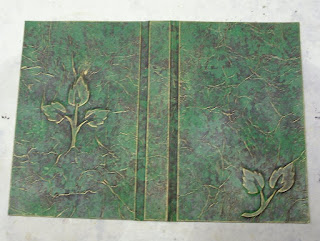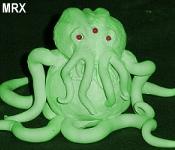After completing the new case I set about casing in the text block. I have been having a little trouble with my end sheets and sometimes some of the first and last pages of the text block getting wrinkled due to the moisture in the glue from when I glue on the mull to the spine and paste down the overhang to the outside of the end sheets. It didn't happen all the time, but sometimes it was very noticeable and it would ruin an otherwise perfect re-covering job. When that happened, I could use it as-is, or tear out the end paper and apply a new one, but if the damage went into the text block there was nothing I could do about it. I have been using blotter pages to try to take up the moisture, but sometimes it didn't seem to help. Recently I have adjusted my technique to combat the problem. Now I use at least two blotter pages AND a piece of waxed paper to stop the moisture from getting to the text block, and on top of that, I have changed the way that I do end papers to help eliminate the ugly wrinkles.
Instead of using a single folded sheet for the end paper, attached to the first and last signature with a dry roll-on adhesive, now I use a double end paper. I take TWO folded sheets, one which will be the final decorative end paper, and a plain white sheet. I use the dry adhesive, as usual, along the edge of the decorative end paper, but instead of applying it to the text block, I place in within the fold of the plain white sheet. Then, I adhere the plain white sheet to the text block as I normally would. So I end up with and papers that are a two sheet signature, with the decorative paper on the inside surrounded by a plain white sheet. This will give me one extra blank white page at the beginning and end of the text block, and a white page interceding between the mull and the end paper. The mull gets glued down to the white page instead of the end paper. Then the white sheet is pasted down to the boards, using spray adhesive, like I normally would do to the end paper. Afterward, I will use the spray on adhesive to paste down the decorative end paper also, right on top of the white sheet. This way, if the white sheet gets wrinkled from the glue on the mull, it doesn't matter. A nice clean wrinkle free end paper is going to hide it. I usually trim the white sheet a little smaller than the decorative sheet so that the decorative sheet covers it completely. I do this by tearing instead of cutting, so that the deckled edge smooths down and becomes invisible underneath the decorative sheet. If I cut the white sheet, the edge of the cut sheet might show a little under the decorative sheet.
Sorry, no pictures of the end papers, but that would probably be boring anyway.
UPDATE: I have posted an article detailing the double end paper technique with pictures. You can find it here.
Now on to the final book cover. So where were we... ah yes, we left off with the finished cover ready to be cased around the text block.
I had originally planned on leaving it pretty much at that, and using a title card printed on my computer and glued to the front cover, like so...
I thought that looked pretty snazzy. But I showed it to my daughter and she sneered at it. She said it looked "retarded". Clarifying, she said that it looked like I spend a lot of time and effort on the cover, but the title just looked like a piece of paper glued on it. I was a little deflated, but I had to agree that she had a point. It needed something.
I had been toying with the idea of creating decorative frames for these kinds of title cards, but had never tried it. This looked like the perfect opportunity. I had previously picked up a couple of small cheap picture frames that I thought had potential for this purpose. You can see them in the upper right of this picture.
I set about making a one-shot mold of one of the frames using sulfur free oil based modeling clay. After pressing the frame's face down into the flattened clay, I gave the clay mold a coat of black spray paint. It makes an excellent mold release for this purpose. It bonds to the resin, and it does not add any coating that will hamper further painting like silicon mold release will do.
After creating the mold and spray painting it, I poured polyurethane resin directly onto the clay mold. After 15 minutes or so, I removed the casting, which destroyed the clay mold. After demolding, there is still a good bit of clay stuck to the surface of the casting. This cleans up easily with a squirt of Goo Gone, some water and a scrub brush. The Goo Gone also takes off the spray paint from the plastic, but that doesn't matter, as it will be repainted any way.
The resin casting took a fair bit of cleaning up with a hobby knife before it was ready for use. Then it got a flat black base coat of spray paint and a dry brushing of antique gold acrylic paint and a bit of gold Rub-N-Buff. Fortunately, the title page that I had glued on seemed to come off really easily (bad gluing job I guess). Call it kismet. While I was gussying up the front cover, it only seemed right to add a satin ribbon book mark as well.
And of course, my hand sewn headbands.
The paper title card was slightly too large to use in the frame, so I had to print out another one. I decided to change the fonts up a bit from my original design. I printed out three new designs and spend longer than usual choosing which one to use. Once I decided, I glued it onto a card stock backing to give it some body and prevent the wrinkles in the covering material from affecting it. Then I glued it to the underside of the frame and then the frame to the cover. Here is the final selection, neatly placed on the front cover.
 |
| The finished product. |
Ta-da!
Here are some more glamor shots of the finished item.
Aside from this book being a misprint, and having a small spot of paint on the edge of the pages from being stored. The only flaw in this book is that I lost a little of my square at the fore edge. Just a millimeter or so, and it's still usable, but it made the square a little off. I will adjust for this in future bindings.
P.S.- My renewed and continued thanks to Propnomicon for linking to Part One of this post. Since it doesn't have much to do with Cthulhu, I suppose it must have been a slow news day in Mythos land, but I am grateful for the traffic bump anyway.






























The book is quite a beauty with the wrinkled paper, the colour combination and the frame (your daughter was right ^^).
ReplyDeleteAnd it just happened that I came by seeing your link at Propnomicon!
*waves*
It may not have much to do with Cthulu, but it does have to do with creating quality props, another aspect of Propnomicon.
ReplyDeleteAs someone who has never done bookbinding before, I got a bit lost with the first section when you are talking about endpapers and such. Pictures here would not be boring. I am sure if I take the time to read up and view the YouTube links provided in part 1, I will have a better understanding, though.
Great job and thank you for sharing your technique.
Thanks. I do have other posts that detail some of those early steps, such as the end papers. You might want to check out some of my other posts with the Bookbinding label.
ReplyDeleteI'd really be interested in seeing the dual-end papers hack you mentioned. Your English description is good, but my visually-oriented brain can't seem to make the connections.
ReplyDeleteYour blog has inspired me to do my own re-binding work. I never noticed how much of what is required was just sitting around my workspace, just waiting to be used.
Thanks for the inspiration!
Glad to hear I have inspired you.
ReplyDeleteI will try to put up some more pics and a more detailed tutorial about the end papers for those who have expressed interest.
I've finally added a post that clarifies the double end paper hack described at the beginning of this post. You can find it here:
ReplyDeletehttp://mrxdesigns.blogspot.com/2013/11/book-binding-with-double-end-papers.html